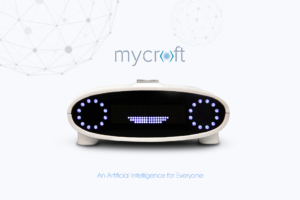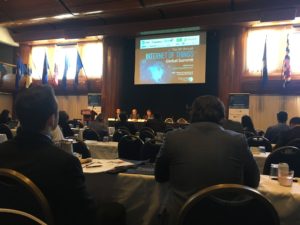Aiden Quilligan, Accenture Industry X.0, on AI:
- Mindset and AI: must undo what Hollywood has done on this over years, pose it as human vs. machine.
- We think it should be human PLUS machine.
- he’s never seen anything move as fast as AI, especially in robotics
- now, co-bots that work along side us
- exoskeletons
- what do we mean by AI? Machine learning. AI is range of technologies that can learn and then act. AI is the “new work colleague” we need to learn to get along with.
- predictions: will generate #2.9 trillion in biz value and recover 6.2 billion hours of worker productivity in 2021.
- myths:
- 1) robots evil, coming for us: nothing inherently anti-human in them.
- 2) will take our jobs. Element of truth in terms of repetitive, boring work that will be replaced. They will fill in for retiring workers. Some new industries created by them. Believe there will be net creation of jobs.
- 3) current approaches will still work.
6 steps to the Monetization of IoT, Terry Hughes:
- Digital native companies (Uber) vs. digitally transforming companies
- also companies such as Kodak that didn’t transform at all (vs. Fujifilm, which has transformed).
- Forbes: 84% of companies have failed with at least one transformation program. Each time you fail you lose 1/2 billion
- steps:
- 1) devices with potential
- 2) cloud network communication
- 3) software distribution
- 4) partner and provider ecosystem
- 5) create a marketplace.
- 6) monetization of assets.
- crazy example of software company that still ships packages rather than just download because of initial cost in new delivery system
- 3 big software challenges for digitally transforming company
- fragmented silos of software by product, business unit & software
- messy and complex distribution channels
- often no link between software and the hardware that it relates to
- importance of an ecosystem
- Blackberry example of one that didn’t have the ecosystem
- 3rd parties will innovate and add value around a manufacturer’s core products
- in IoT it’s a land grab for mindshare of 3rd-party innovators.
- need strong developer program
- tools for app development and integration
- ease of building and publishing apps
- path to discovery and revenue for developer
- IDC: developer ecosystem allow enterprises to massively scale distribution
- digitally native companies have totally different models (will get details later…)
- hybrids:
- GE Healthcare: working with Gallus BioPharma
- Heidelberg & Eig have digital biz model for folding carton printing. Pay per use
- Ford is heading for mobility as a transformation
Bernard Marr: Why IoT, Combined With AI and Big Data, Fuels 4th Industrial Revolution
- connecting everything in house to Internet
- Spotify: their vision is they understand us better. Can correlate your activity on Apple Watch (such as spinning) & create a play list based on that)
- FitBit: the photo will estimate your calorie content.
- John Deere
- ShotSpotter: the company that monitors gun shots
- understanding customers & markets better than before:
- Facebook: better at face recognition than we are. They can predict your IQ, your relationship status.
- Lot of frightening, IMHO, examples of AI analyzing individuals and responding without consideration of ethics and privacy
- 3) improving operations and efficiency:
- self-driving boats
- drones
- medicine through Watson
panel on IoT:
- Don’t be afraid of the cloud
- Ryan Cahalane, Colfax: prepare for big, start small and move fast. They had remarkable growth with switch to IoT. Not a digital strategy, but digital in everything they do. Have “connected welders,” for example.
- Justin Hester, Hirotec: most importatnt strategic digital transformation decision your organization can make is the selection of a platform. The platform is the underlying digital thread that enables your team to meet the unique and chanding needs of your organization and to scale those solutions rapidly. “Assisted reality” in ThingWorx
- Shane O’Callahan, TSM (Ireland): Make industrial automation equipment for manufacturing. Understanding your key value driver is where to start. Then start samll, scale fast and get a win!
Jeffrey Miller, PTC: Digital Transformation:
- if you start with digital strategy you’re starting in wrong place Start with business strategy.
- Couple with innovation vision merged with digital strategy. Add business use cases.
- Jobs: it’s not how much you spend on R & D, but “about the people you have, you you’re dled, and how much you get it”
- create an environment for innovation
- do we encourage experimentation?
- is it ok to fail
- identify digital technologies to provide the required operating capabilities:
- have we conducted proofs of concept?
- experimented, tested and validated?
- reviewed use cases & success studies?
- delivered small, important, scalable successes?
Matt, PTC: Bringing Business Value to AR:
- augmented service guidance
- remote expert guidance
- manufacturing: machine setup and turnover, assembly and process
- example of Bell & Howell towers to store online sales in WalMart stores for customer pickup: very expensive to send one to a store for salesperson to use in sales — now just use AR app to give realistic demo without expense.
- service: poor documentation organization, wants accurate, relevant, onsite info for technician. Want to remove return visits because the repair wasn’t done 1st time, or there’s a new technician. Manuals in binders, etc. Instead, with AR, requirements are quick access to current info. Finally, a demo.
Suchitra Bose, Accenture: Manufacturing IIoT, Driving the Speed of Digital Manufacturing:
- convergence of IT and OT
- expanding digital footprint across your entire factory
- PTC has wide range of case studies (“use cases” in biz speak…) on aspects of IoT & manufacturing.



